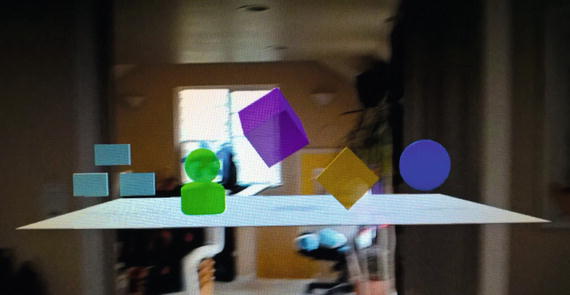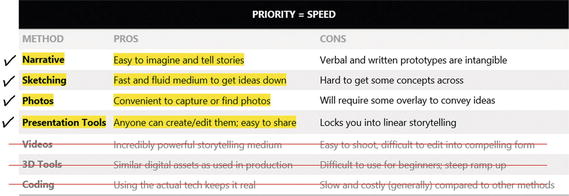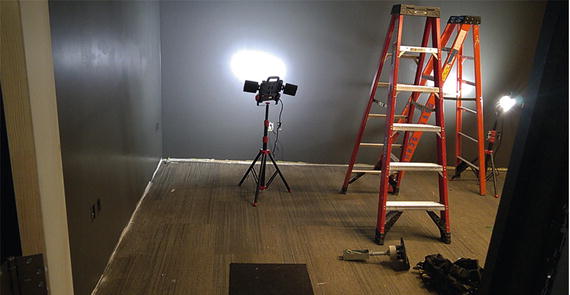So, you wanted to see it actually work?
The prototyping phase of envisioning is all about putting it in gear and mashing the accelerator down to the floor. We need to create something tangible to experiment with quickly, because the greatest ideas don’t amount to diddly squat if people can’t try them out themselves on some level. We need to make ideas just real enough to judge whether they’re making a connection with the participant or not.

Prototype using simple shapes to quickly get on-device positioning correct
Preflight

Figure out what envisioning aspect you are going to prioritize up front
Another aspect to consider before doing anything else is thinking about potential issues that we may run into that could delay or derail things. Nothing should stop us from moving ahead with the idea, but it is handy to preflight the good and the bad that could happen as we start moving quickly. What’s the biggest challenge you can think of right off? No big deal really, or it’s really going to take some effort to figure that one out? Either way, give it a quick thought before jumping in. Could turn out that quick thought changes how you’ll answer some key questions.
What special equipment will you need to run down your idea? Do you just need relatively simple means to get the idea across or does it require a full-blown VR setup and skilled crew to help? Is a special room or setup required? What resources do you have access to?
All those questions should be thought about quickly during the preflight check.
Focus
Before we leap headlong into our prototyping exercise, we need to reflect back on the real reason for creating the prototype in the first place.
Are we trying to get our idea in front of others as quickly as possible? Does our idea need to dramatically impact someone’s thinking? Is our prototype meant to silence the critics by demonstrating something technically difficult can actually be achieved? Something else?

Efficient prototyping requires identifying your focus early on
The choice typically falls into one of three categories – seizing an opportunity, making an impression, or doing a technical proof. Since there will always be prototypes, let’s just pick. Choose whichever focus suits you. Got one? Great. Now let’s figure out how to get the prototype done.
Priority
It’s often said we can’t really focus on more than one thing at a time. In a similar way, you really won’t be able to go very quickly through the prototyping phase if you try to prioritize more than one key aspect of the process.
There’s an old saying among project managers that out of the three main aspects of projects to keep in balance (speed, quality, and cost), you can really only have two. Same thing applies in prototyping. There are natural tradeoffs that prevent you from achieving all three. If you go fast, you suffer on quality. If you dig in on quality, you sacrifice speed and cost, etc. Except, I’d go even further with mixed reality prototyping and say you should consider focusing on just one goal from a process standpoint.
Ruthlessly prioritize just one aspect of your prototyping.
For example, getting the basic idea of your holographic experience across as quickly as possible (speed) will prevent you from going super deep on details (quality), but it will probably save you time and effort (cost). That’s fine if we’re making speed the priority. Sacrificing some quality and reducing the amount of work put it gets us to done.
Another example is committing to coding up an actual working demo of a key aspect of the experience (quality). You know it will take additional time and money (cost), but without that extra effort your idea may not be able to proceed much further and lose momentum (speed). Sometimes making it real for people is the right choice despite the longer development time.
The tradeoffs here are endless. Fortunately, there are some pretty clear reasons why you’d want to prioritize one aspect over another that we can use as guidance.
1. Window of Opportunity
If your goal is to capitalize on a situation that will evaporate quickly, there’s no choice but to prioritize going as fast as possible when creating your prototype (whatever form that may be). We all have stories of not being able to react quickly enough when opportunities present themselves, and they are no fun at all to retell. If the window is open, go for it.
Priority = Speed
When you have to force something into existence to illustrate an idea quickly, there’s no question you have to prioritize speed of execution over everything else, even if that means the overall quality is lower than you’d like or it costs more to do because of the time crunch. This holographic computing space is moving at light speed, so the limited window of opportunity aspect will rise to the top fairly often. Embrace the chance to haul ass and get things done as fast as you possibly can. It’s actually a nice change if you work on product teams to play it fast and loose rather than have to apply rigor to everything you do.

Table 11-1. The impact of focusing on speed in prototyping
Speed = Quick Prototypes
When speed is the priority you’re looking for mediums and methods where you can get to the tangible output fast, but that doesn’t mean you have to remove any of the methods available to you. Some people are almost as fast coding something up as others using a dedicated prototyping tool to create in. This is where you need to look closely at your collective skillset and match the vehicle to the talent.
Make an Impression
If the goal is to blow away the people who see your prototype for the first time, spend all your time figuring out what that signature moment is and spend all your time making that work flawlessly. Put your emphasis on a quality experience showing off that key capability.
Priority = Quality
There’s never a second chance to make a first impression they say, so if you have to nail that first exposure to the idea, quality is your priority. There are times when you absolutely have to portray the idea in the best light possible, whatever the cost in time or resources. That means investing in the story flow, getting key interactions right, high quality visuals, and possibly making it a working demo to really blow people away when they see it.

Table 11-2. The impact of focusing on quality in prototyping
Quality = Impressive Prototypes
Making a big impression doesn’t mean you have to prototype your concept to the nth degree of detail or have every whizzbang feature you thought of. What it does mean is you do have to deliver something stunning and memorable to your audience. There’s lots of ways to get there, not all of them artistic or technical. Using the element of surprise is one of the prototyper’s best tools, regardless how it is played out. Find a way to be impressive with your method of choice.
Technical Proof
There are times when important people just won’t believe you can pull off that new-to-world feature of your holographic experience, no matter how well you describe you’ll do it. Those are the times you’ll have to dig in and write the code or create hardware to prove it’s possible. There’s an old saying that goes “Code wins.” It’s true.
Priority = Cost

Table 11-3. The impact of focusing on cost in prototyping
If you’re lucky enough to have access to super talented engineer who can create a technical proof almost as fast as a designer can put together a good wireframe, you’re golden. That’s really the optimal situation for technical prototyping since the overall speed is not necessarily sacrificed by building out working tech. If things are more iffy than that – perhaps the tech is new and full of unknowns, chances are this form of prototyping will take the longest of any other. It may be completely justified, but it can get away from you from a time perspective if you don’t pay attention to actual progress.
Cost = Technical Prototypes
Doing anything with real code and/or hardware is a time sink any way you look at it. Yes, people can be incredibly fast at what they do – but there’s so many things that can go wrong with this approach of creating something real you have to watch really carefully for cost overruns and estimates being way under.
Methods
Now that we are clear on our priority for this prototype, let’s figure out what method to use. We have talked about lots of different ways to test our ideas out, but which is the best one for this particular idea, focus, and priority? How do we determine that?
The method you choose has a lot to do with who you are, what skills you have on your team, or what you hope to learn during this work.
For Designers

Designers should jot down some key aspects for Devs, not just jump into sketching
Narratives come naturally to many designers as we are required to be storytellers in our roles. Being able to verbally convey an exciting story about breakthrough experiences should be relatively easy for many designers.
Storyboarding is almost an everyday thing for designers, so this will tend to be a very quick way to illustrate holographic concepts through sketching out frame-based stories like you’d see in film production.
Visual walkthroughs can be done using art tools and a playback mechanism like web pages or presentation software. A good example of this is a PowerPoint deck that contains some transitions and animation to get the basic feel across.
Design clickthroughs are typically created using specialized tools for rapid prototyping. These apps let you link screens together to allow for unattended demos.
AR videos are a quick way to get the basic gist of a holographic experience across by leveraging the real world, which is really the point of all this. This is a great choice to illustrate how things will work in physical spaces by using AR photo effects on your phone or tablet as the enabling mechanism.
Acting things out is seemingly a low fidelity way to illustrate experiences, but it’s without question one of the best methods. The involvement of people as holograms within experiences brings an unlimited amount of functionality to any scenario since it’s being driven by people instead of canned imagery or constrained software.
3D scene-based prototypes are done using software that allows the composition of 3D models, sound, lighting, and interactivity into spatial scenes. Much like game development tools, these specialized apps can output full fidelity mixed reality experiences that are deployed to devices.
Code prototypes are not out of reach for multi-talented designers. In fact, many younger designers are just as comfortable coding as they are slinging pixels. If you can code up your ideas and get them onto actual devices, you’re a unicorn rock star. Leverage it.
For Developers

Get your code prototypes onto a real device as soon as possible to avoid costly mistakes
Narratives are thought of a bit differently by developers. They typically would tell the story of the breakthrough experience as tech walkthrough on a whiteboard, diagraming and talking about specific aspects of the tech and ecosystem. Just as effective in many ways as anything a designer would do for the right audience.
3D scene-based prototypes use the same composition apps used by designers, but devs will be able to bring a lot more interactivity and special behavior to the scenes created within the tool via scripting languages or writing custom code. These are super high quality when teaming with a designer for higher quality artwork and assets.
Code prototypes are what developers do naturally. They are super-fast and good at developing at this level of fidelity and functionality. These working code prototypes are the best we can do if a technical proof is required to persuade nonbelievers.
Hybrid prototypes bring together hardware, software, and services in new and novel ways. They can typically only be executed by Makers, those of us who are comfortable connecting hardware elements with custom software. Often needed for innovative demos.
For Storytellers

Storytellers will want to channel their best Don Draper in the conference room
Narratives are the core competency of storytellers. We are really good at not only telling a good story, but one that’s memorable. That’s gold in the prototyping world.
Storyboards serve as the primary way to visually convey stories over a period of time. It’s not difficult for anyone to draw up a frame-based storyboard, but there’s a real talent to doing it in way that emotes the right level excitement to hook participants.
High production value videos are things of beauty. They are what every designer wishes could be done for their ideas, but they typically don’t have their own budgets for these types of undertakings. These are long and involved to produce, but worth it for setting vision of what could be in a convincing and memorable way.
Funding code prototypes is not that common for storytellers, but look at what producers like James Cameron and George Lucas are able to accomplish by doing early stage technical proofs as motion tests before funding major motion pictures. Same principle.
Environment

Prototyping environments can be as simple as your desk, or take up an entire room
The setup for doing your prototyping and experiments is in many ways just as important as the methods you choose to execute them. Mixed reality is all about putting holograms within our world, physical or virtual. The backdrop for your prototyping could be as simple as the workspace you are in. What’s in your workspace that’s interesting. Do you have a working VR setup or immersive headset to try ideas out with?
Whatever prototyping environment you decide on at first will inevitably change over time.
Output
Regardless of who you are, how you work, and who’s on your team, the output of your rapid prototyping work is the only thing that really matters. You need to get tangible demos in front of people, so ride like the wind to get those demos out there in people’s hands at the right level of fidelity and quality given the time you have allocated to get the job done.
A win is a win, they say. That couldn’t be more true for prototyping.
